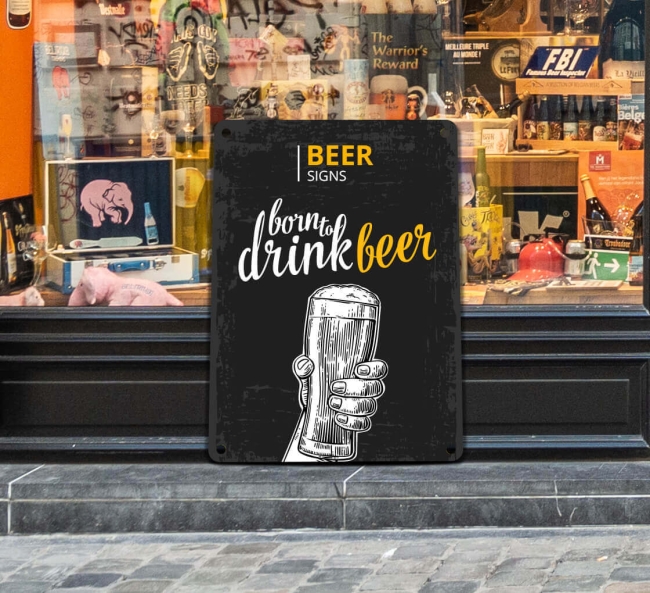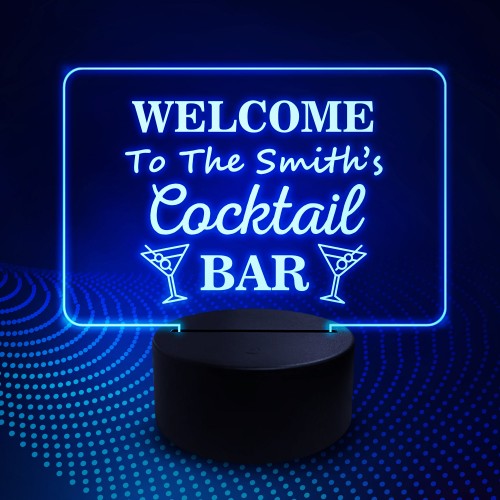Great Tips To Picking Bar Signs
Great Tips To Picking Bar Signs
Blog Article
How Do Bar Signs Differ In Their The Purpose?
Bar signs are used for a myriad of reasons. Bar signs are used for many different purposes. Branding
The purpose of this logo is To help strengthen and grow the bar's brand.
Usually, it is the bar's logo and name, or its signature colors. The concept is to reflect the theme and feel of the bar.
For instance neon signs that feature the bar's logo, or metal signs with a bar's name.
2. Information
Goal: To provide patrons with important information about the bar.
Features Text that is simple to read and communicates vital information such as times of operation, Wi Fi passwords, house regulations, or restroom place.
Examples: Wall-mounted signage near the entrance that state the hours of operation, or signage pointing towards restrooms.
3. Decorative
Goal : To enhance the appearance and ambience of the bar.
The features are usually artistic or thematic and add to the look of the bar in general. It might not include any particulars or text.
Examples: old advertising for beer, funny or fun signs, themed artwork.
4. Promotions
The purpose of this is to promote a specific product, event or a specific.
Features: Design that's appealing, and emphasizes particular offers, upcoming occasions or menu items. It could include temporary or changeable components.
Examples include chalkboards featuring daily specials, banners for happy hour offers, and posters promoting forthcoming events.
5. Directional
Use for directing customers to the correct bar.
Highlights: Clear arrows or instructions for customers to navigate the space, such as getting to the restrooms, exits, or various areas within the bar.
Examples: Arrows for direction for different seating locations.
6. Regulatory/Compliance
The purpose is to comply with legal requirements and to ensure safety.
Features: Necessary signs that meet legal requirements for example, the location of smoking zones, maximum occupancy limits, and emergency exits.
Examplesinclude "No Smoking", occupancy limits, evacuation signs for emergencies.
7. Interactive
Goal: To connect with customers and provide an engaging experience.
Features: The elements that promote patron participation such as surfaces that you can write on, or use digital interactions.
For instance, chalkboards that can be used to write messages to customers, or signs with QR code links to digital menus and social media.
8. Thematic
Goal: To develop an atmosphere or theme.
Features: Signs that match the theme of the bar and add to the overall atmosphere.
Examples: Pirate-themed signs in a nautical bar or rustic wooden signs for an establishment themed on the countryside.
9. Menu
Use for: Shows the bar menu.
Features: Lists clearly the food and beverages and food items, usually with prices. It can be static or it can be changed.
Examples include rotating digital menus on screens, or on wall-mounted menus.
Each type of bar signs serves a specific purpose and is designed to perform its particular function in the bar. Bar owners who are aware of these differences can choose and position signs that will enhance the experience of their patrons while also meeting their business needs. Have a look at the most popular click for source for bar signs for home bar for website info including personalised pub signs for garden, make a pub sign, a bar sign, pub bar signs, personalised sign for bar, buy bar signs, personalised outdoor pub signs, outdoor home bar signs, pub signs, pub signs for home bars and more.
What Are The Differences Between Bar Signs When It Comes To Mounting And Installation?
There are different ways to mount and install bar signs depending on their size, weight and location. Let's take a closer, in-depth look at the different mounting and installation methods for bar signage: 1. Wall-Mounted Signs
Fixed directly to walls.
Methods:
Anchors and Screws: Usually used on heavier signs (metal & wood) to ensure stability.
Adhesive Tape: Can be applied to signs with a lighter weight, such as foam board or acrylic.
Brackets - These are used to increase the visibility of signs by allowing them protruding away from the wall.
Uses: Indoor decor, menu boards, directional signs.
Benefits: Versatile, safe and allows for impressive display.
Unfavourable: Walls can be damaged, and it is difficult to move the item.
2. Hanging Signs
Particularities: Ceilings suspended from the ceiling or overhangs.
Methods:
Chains are durable and adjustable, perfect for heavy signs.
Cables: Contemporary designs often use cables for their sleeker appearance.
Rods: Provide a rigid support structure.
Uses: Ceiling decor, directional signs, overhead promotional signs.
Benefits: High visibility Uses vertical space and can also be used for decoration.
Advantages
3. Signs for Freestanding Places
Characteristics: Does not attach to any structure. Supported by a base or stand.
Methods:
A-Frames are portable and foldable. They are commonly used to advertise along the street.
Pedestal Stands: Stable base, ideal for indoor use.
Post and Panel is a common word used to describe large, permanent signs.
Uses: Outdoor advertising, indoor directional signs, promotional displays.
Portable, versatile and easily repositioned.
Advantages
4. Window Signs
Characteristics: Attached directly to windows directly.
Methods:
Suction cups: Easy to remove, install and suitable for lighter signs.
Adhesive Glass can be directly applied to the glass's surface. It is ideal for decals, graphics and other graphics.
Static Cling is permanent but it is reusable. It's also easy to apply.
Uses: Promotional messages and branding Operating hours.
The window is extremely visible, and it maximizes the area available.
Cons: Limited by window size, can be affected by sunlight.
5. Signs that have Backlit Edge-Lit and LEDs
Features: Include lighting into the sign structure.
Methods:
Wall mounting: This requires an appropriate attachment as well as electrical connections.
Suspended Power Cables Combining hanging technique and integrated lighting.
Applications: High-visibility brands, menu boards, decorative items.
Benefits: Better visibility, attractive lighting.
Disadvantages: Requires electrical work and requires more intricate installation.
6. Portable and Temporary Signs
Specifications: Designed to be easy installation and removal.
Methods:
Pop-Up Stands: Light and compact.
Banner Stands: Roll-up or retractable designs.
The uses include: celebrations, events and seasonal decorations.
Advantages: Easy to carry easy to set up and transport.
Disadvantages
7. Magnetic Signs
Attachment using magnetic force.
Methods:
Magnetic Strips: Attached on the back of the signs.
Magnetic Boards. Signs attached to metallic surfaces.
Uses For: Temporary notices, menu boards that can be modified.
Advantages: Easy to install and take down without the need for permanent fixtures.
Disadvantages : Limited to areas with magnetic properties, less secure.
8. Projection Signs
The main features The use of light to show an image or text.
Methods:
Projectors mounted: They can be easily hung on ceilings or walls.
Portable Projectors can be set on stands or other surfaces.
Uses include: dynamic displays, events, and promotions.
Advantages: No need to purchase the physical sign, since the content can be easily changed.
Negatives
Considerations to be taken into consideration when mounting and assembly
Weight and Size
The heavy signs (Heavyweight) They need more durable mounting solutions, such as bolts and screws.
Light Signs - You could employ less complicated techniques like suction cups or strips of adhesive.
Durability
Permanent Signs: Use mounting techniques that are more sturdy and secure.
Temporary Signs - Choose an option that permits simple removal and repositioning.
Location
Indoor: Less concern with weather resistance, more flexibility of materials and methods.
Outdoor: The materials that are used for outdoor mounting must be weatherproof and require a solid mount.
Aesthetics
Concealed Mounting: Provides an elegant appearance by concealing hardware.
Decorative hardware: Enhances the look of a sign.
Accessibility
Simple access to make changes Perfect for signage that needs to be regularly updated like menu boards.
Security: Make sure that signs are not easily tampered with or stolen.
By considering these factors the bar owners can select the right mounting and installation methods that best suit their specific needs, ensuring the security of their signage and visible. They should also be in line with their bar's aesthetic and functional needs. Check out the top pub signs for website recommendations including a bar sign, the staying inn bar sign, home garden bar signs, garden bar sign personalised, pub bar signs for sale, bar signs for garden, pub bar signs for sale, home pub signs, pub signs for garden, pub bar signs and more.
How Do Bar Signs Differ From One Another In The Area Of Interactivity?
Bar signs may incorporate different levels of interactivity to attract patrons and improve the overall customer experience. Here's how bar signage differ in the realm of interactivity. Static signs
Traditional Design: static signage transmits information without any interaction.
Common Types: printed posters, painted murals, or the standard neon signs.
2. Digital Displays
Digital signs are capable of showing live-time content, including multimedia, animations and even updates.
Touchscreen displays can be used to play interactive menus and games as well as promotional content.
Benefits: Draw the attention of customers, communicate relevant information, and increase patron engagement.
3. QR Codes
Interactive Links QR codes that are displayed on signs can open menus as well as social media profiles and even promotions.
Benefits: Make it easy to access more information, promotions or loyalty programmes.
4. LED Screens
LED screens can be used for displaying scrolling text or animations.
LCDs with touch capabilities let patrons interact with content, such as selecting menu items and playing games.
Benefits: Attract attention, communicate information clearly and create immersive experiences.
5. Projection Mapping
Immersive experiences: Projection mapping converts flat surfaces into interactive displays with interactive visuals.
Interactivity: The patrons can engage with interactive elements, like games or virtual experiences.
Benefits include the creation of an atmosphere that encourages social interaction and increases the enjoyment of being in the room.
6. Augmented Reality
AR is a type of enhanced reality, which overlays digital information onto the real world to allow for interactive experiences.
The AR-enabled signage gives patrons the chance to interact with virtual components. For instance, they can view cocktails recipes, and play virtual games.
Benefits : Create an unforgettable experience for your customers, make them feel valued and differentiate yourself from the competition.
7. Motion Sensors
Responsive Signage Motion sensors detect movement and trigger interactivity in the signage.
Interactivity: Signs respond to the movements of patrons by showing animations or changing the contents. They also send specific messages.
Benefits : More engagement, immersive environments and surprising and delighting customers.
8. Social Media Integration
Online Interaction Signs: These can include handles for social media and hashtags to encourage customers to engage on the internet.
User-Generated Materials: Encourage your patrons to post photos of signs on social networks, thereby increasing the visibility and reach of your bar.
Benefits: Increase brand awareness and encourage involvement of the community.
9. Interactive Lighting
Dynamic Effects Signs made of neon or LED equipped with interactive lighting react to touch, sound, or motion.
Signs are interactive and may change the colors and brightness levels or patterns based the way that patrons interact them and the surroundings.
Benefits Create a sense of depth and increase ambiance. Captivate your guests' attention.
10. Gamification
Interactive Games: Signs with games that are interactive and challenge the user to entertain customers and encourage participation.
You may offer discounts or incentives for completing tasks or games.
Benefits : Increases time of stay. Facilitate social interaction. Promote repeat visits.
By incorporating interactive features in signage, bar owners can provide memorable, interactive experiences for patrons. They can also boost the visibility of their brand and differentiate their establishments in a highly competitive market. See the best man cave signs blog for website tips including modern pub sign, bar signs for home bar, buy bar signs, personalised bar signs, the pub sign, bar signs for garden, a bar sign, to the pub sign, bar sign outdoor, personalised outdoor pub signs and more.